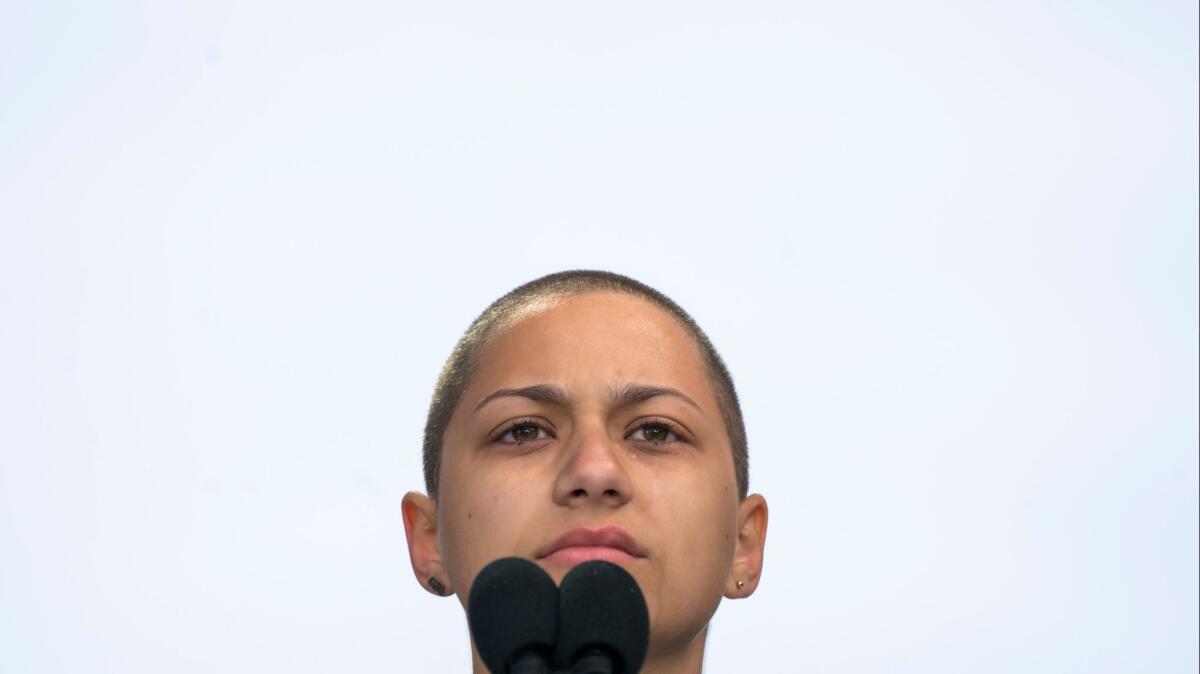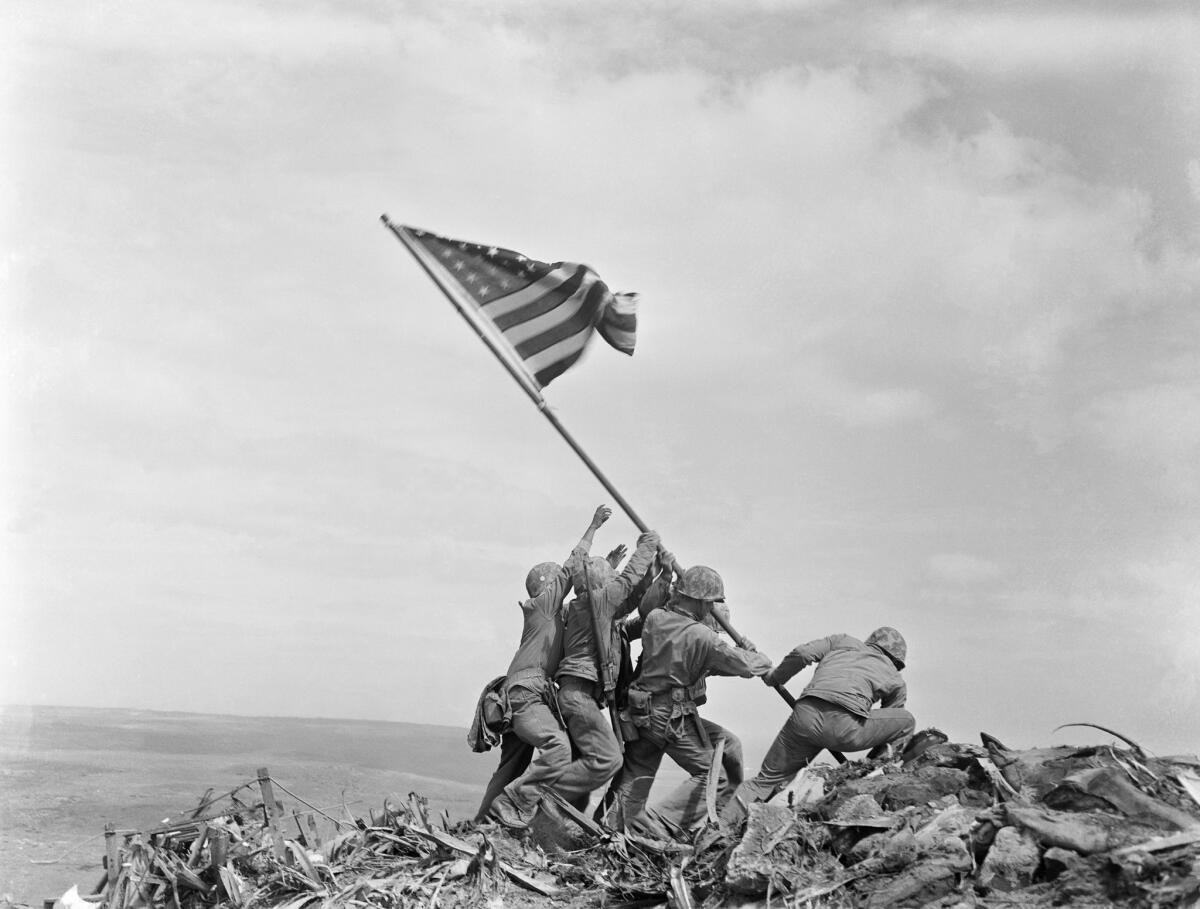Analysis: How images — sometimes manipulated and altered — are shaping the seething world of our politics

- Share via
Revolutions, upheavals and historic change are driven by moments of unflinching clarity distilled into images that move, anger and incite: the 1972 picture of the naked Vietnamese girl burned by napalm or the lined and somber faces of Alabama sharecroppers photographed by Walker Evans that defined the misery of the Great Depression.
Such iconography strikes at the soul, shaping narratives and enduring far beyond the politics of the day. But in our social media-frenetic world, images careen at hyper-speed across a politically divisive and dangerous landscape, where they are celebrated, manipulated and often degraded. A picture can be altered and a video edited with such alarming swiftness and precision that it is difficult to scroll back to its unadulterated original.
Alternate realities have become hobgoblins of our time. We are pummeled by propaganda, battered by hyperbole. Our president furiously tweets about “fake news,” pundits distort events with fun house mirror fervor, activists rearrange truths and Facebook and Instagram bristle with dueling lies. The purity of what we see is elusive, and if we do find it, it is pushed aside by billions of more pixels streaming ever toward us.
The line between subjective truth and propaganda is as old as war, politics and religion, but what’s disquieting today is the velocity at which it moves, and how impossible it is to shove the genie back into the bottle. What are we to believe? Social media have given a populist, liberating edge to what we see, but how do we discern fiction from truth? And will images resonate in the eye long enough to meaningfully shape a generation with an insatiable fascination for the next swipe and click. Below, we discuss the incendiary images coursing through our political divide.
Fleishman: Let’s look at the many iterations of Emma Gonzalez, the Marjory Stoneman Douglas High School student who has become a leading voice for gun control. With her shaved head and tears smearing her cheeks at the recent March for Our Lives rally in Washington D.C., she was portrayed by the left as Joan of Arc, a beatific young woman standing stoically against the sinister forces of the NRA. But in another image — one Photoshopped by right-wing activists — she was depicted as ripping the U.S. Constitution in half. What she was really tearing up was a gun target poster she had been holding during a photo shoot for Teen Vogue. What’s stunning is that in one doctored moment, she became both saint and sinner in our seething politics.
Miranda: The Gonzalez story gets at something that has been an issue for photography almost from the beginning, which is the ways in which photography can lend itself to manipulation. Susan Sontag writes extensively about this in “On Photography.” She notes that photography is often treated as evidence or documentation (scientific photographs or news photography) but that “photographs are as much an interpretation of the world as paintings and drawings are.” Angles and framing and context can imbue an image with a meaning it isn’t meant to have. And I do think viewers are aware of that. People have long been distrustful of the supposed veracity of pictures, which is why you have conspiracy theories about whether the images of the moon landing or the flag-raising at Iwo Jima were staged. (They were not.)

Fleishman: We are deep in a climate of conspiracy. I think you’re right in that manipulation has become an art form all its own. So many hands are working invisibly behind the scenes. What’s notable is that the politics of the day have become crude and blunt — just turn on talk radio or follow a Trump tweet. But how political messages are deployed, and to whom, is an intricate grid of algorithms and personality profiles that reaches into our DNA to illicit passion. Facebook’s admission that the personal information of as many as 87 million of its users was handed to a political consulting firm working to get Donald Trump elected is an example of how our private thoughts and images can be co-opted. They then can be fiddled with and repackaged back to us to get a candidate elected or become fodder in battles over race, immigration and abortion.
Miranda: Images can be manipulated and can manipulate in infinite ways, and that is not new. (Much of Western art history is essentially an ad for Christianity.) But technology has added to the haziness. The 20th century saw the birth of the form known as the photo montage. World War II-era artists like John Heartfield collaged pictures in ways that made them read like a combination of photo and political cartoon. (The Metropolitan Museum of Art in New York has a great piece by him that features a Christmas tree made up of swastika-shaped branches.)
And you have prankster artists like Yves Klein, who were deliberately manipulating imagery as a way of playing with emotion. His 1960 work “Leap Into the Void,” which is part of the permanent collection at the Los Angeles County Museum of Art, shows him throwing himself off a building onto a sidewalk. Needless to say, that didn’t happen. The image is a composite. Klein had a bunch of friends catch him with a tarp.
Interestingly, after the fake Gonzalez image circulated, I saw a response on Twitter (on an account that has since been deleted) that shows NRA spokesperson Dana Loesch purportedly burning the Constitution. The image is manipulated — taken from a film in which Loesch instead threatens to burn the New York Times. It was fakeness slapping back fakeness with more fakeness.
If Gonzalez ripping the target reminded me of anything, however, it was the famous image of singer Sinead O’Connor tearing up a photo of Pope John Paul II on live television in 1992. It appears that we like to continuously echo our most iconographic images.
Fleishman: Speaking of echoing iconography, how about the images last year of white nationalists marching in the night with torches in Charlottesville, Va.? They were protesting the proposed removal of a statue of Confederate Gen. Robert E. Lee from a local square. But the scene was right out of 1930s Germany. Some of the men chanted the Hitler-era slogan “blood and soil.” The images were disturbing and riveting, laying bare the nation’s racial divide in a collage of photographs and videos that evoked the Ku Klux Klan, the Civil War and Nazi salutes. They were a rallying cry for a cottage industry of alt-right websites and blogs, and a warning of the violence racism can provoke.
I wonder, though, if the ceaseless barrage of images is making us numb. There’s too much to comprehend. Our attention spans are shrinking and it’s as if technology and social media are rewiring our sensitivities and sensibilities. Images that once stayed in the collective imagination, such as the girl kneeling over the dead body of a Kent State protester in 1970, don’t resonate as long anymore. They are pushed aside by other images, some that are true, others fabricated. Are we reflecting deeply enough to parse what’s true from what’s not? If we’re not, what does it say about the decisions we make as a nation?
Miranda: Sontag was prescient about all of this too. In “On Photography,” which was published in 1977, she writes: “Photography has become almost as widely practiced an amusement as sex and dancing.” It “has become one of the principal devices for experiencing something.” If only Sontag were alive for the age of duck-lip selfies and cappuccino Instagrams. About half a dozen years ago, Dutch artist and curator Erik Kessels had a project in which he printed out 24 hours’ worth of digital images and filled a space with them, floor to ceiling — a literal mountain of images.
But as overwhelming as this deluge is, it has democratized image-making. It’s not just media or government or hallowed institutions defining what we see, it’s everybody. Iconic images of police violence against unarmed people, for example, are often captured by ordinary bystanders. And while individual images may travel through the collective unconscious at warp speed — the photo of Trump and the orb felt like a lifetime ago, but it was just last year — I find that photos now have a new resonance as a curious form of communication, almost like hieroglyphs.
Nowadays, it is common to respond to a written message with a photo. And image macros (memes featuring an image and a short line of text) can deliver an effective political message in the space of a smartphone screen. Photographs still have currency, just not in the way they used to. In this day and age, the iconic image might not be Kent State. It’s Kermit the Frog drinking a cup of tea.
So, are we doomed? Could be. But not for reasons that have anything to do with photography.
See the most-read stories this hour »
Twitter: @JeffreyLAT, @cmonstah
[email protected], [email protected]
ALSO
Mark Bradford on making art in post-shock phase of the Trump era and how comics channel this moment
More to Read
Only good movies
Get the Indie Focus newsletter, Mark Olsen's weekly guide to the world of cinema.
You may occasionally receive promotional content from the Los Angeles Times.











